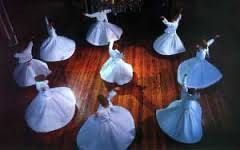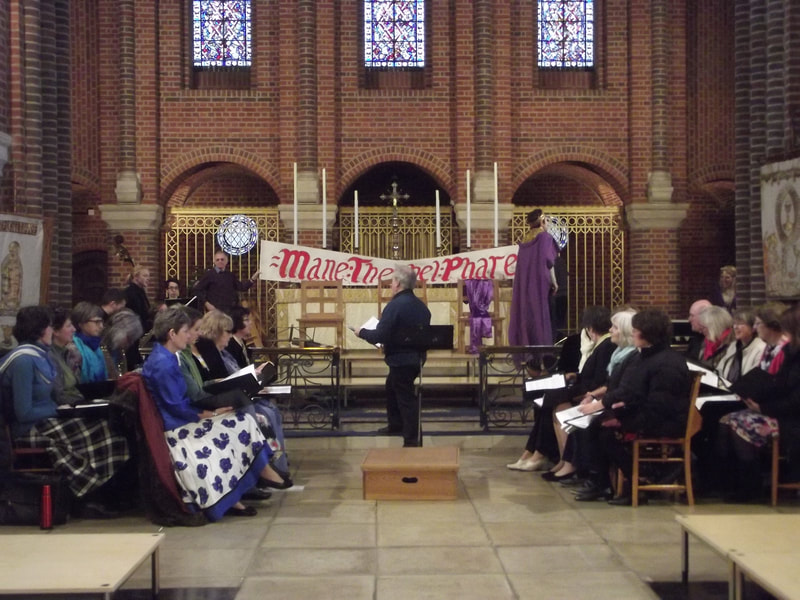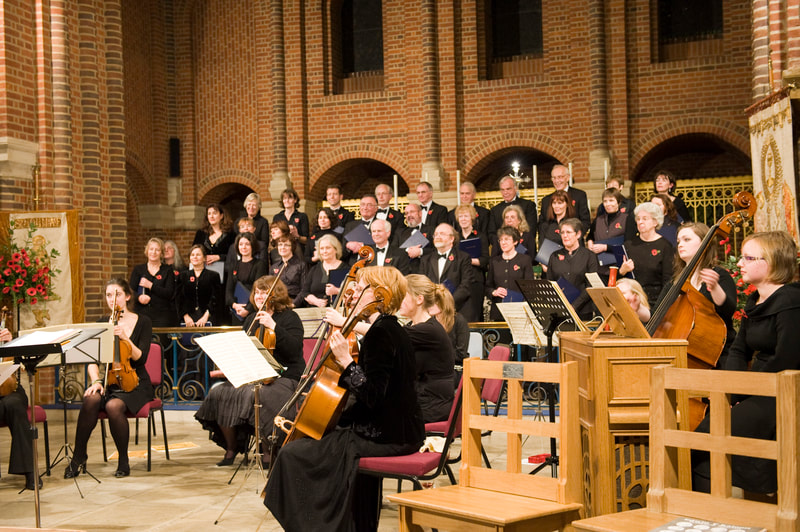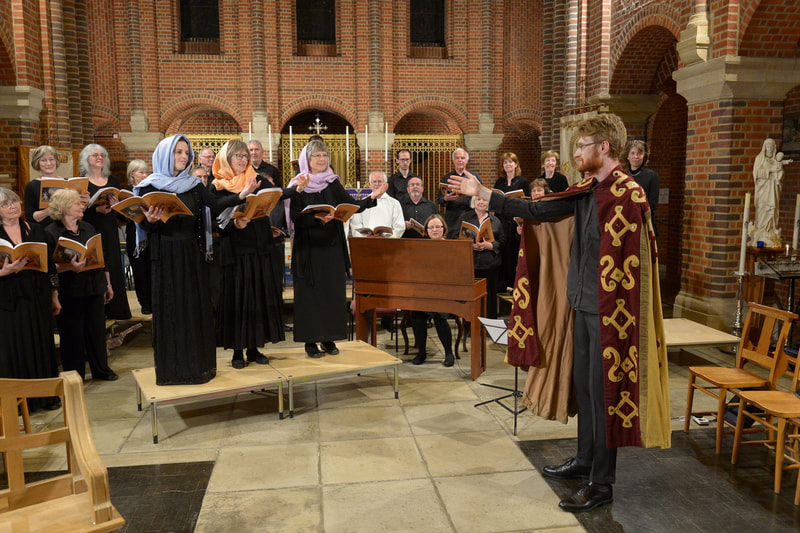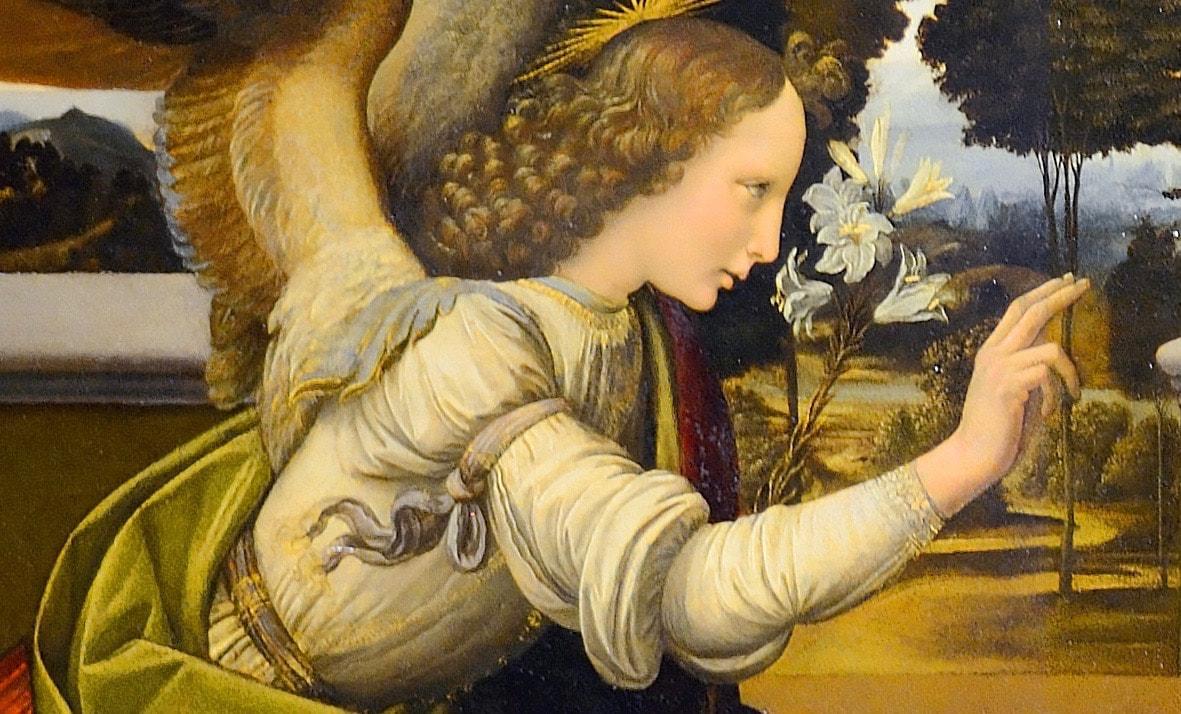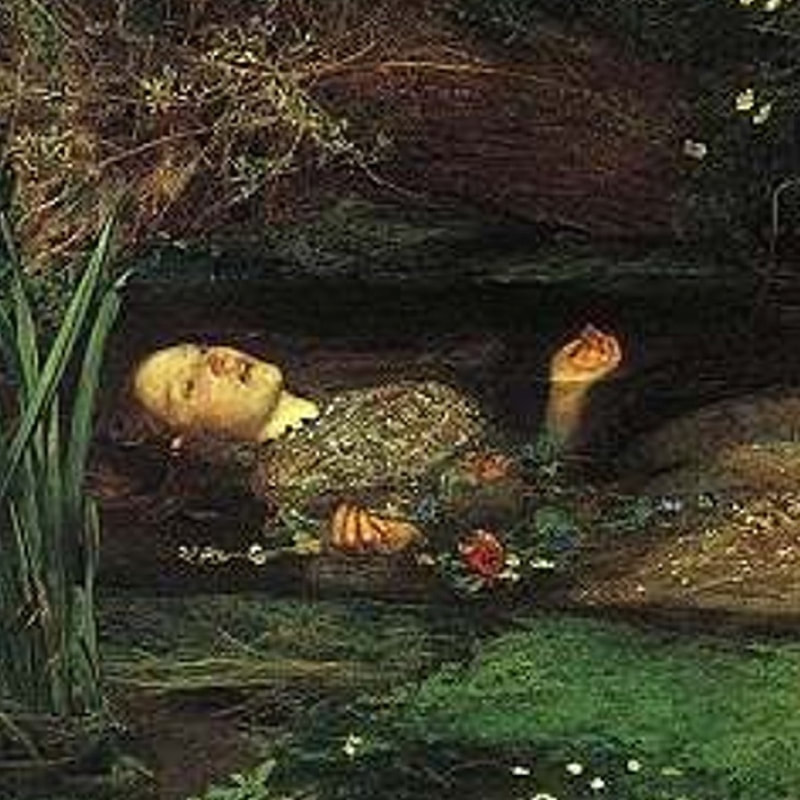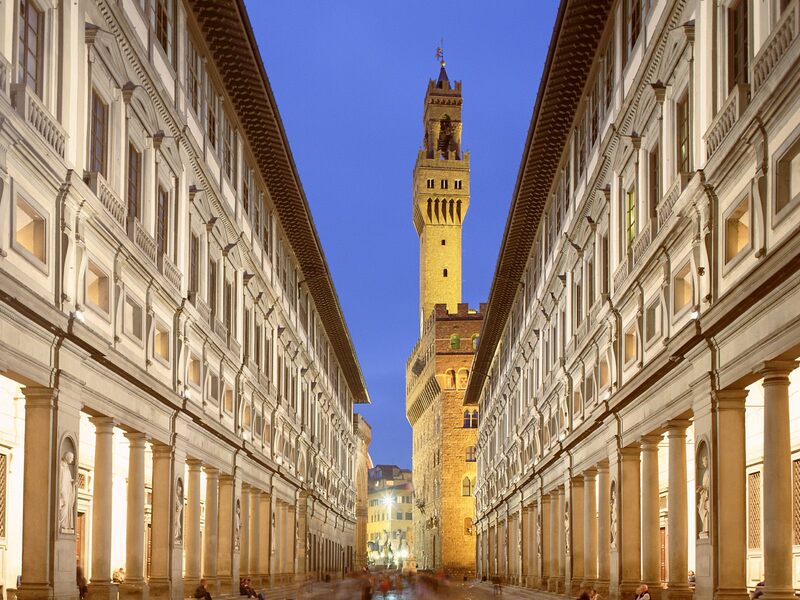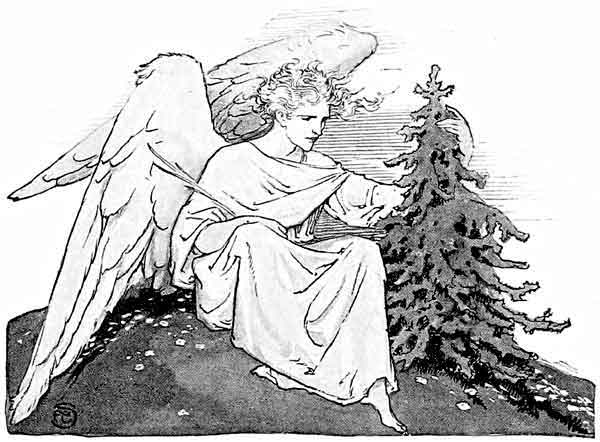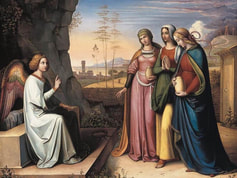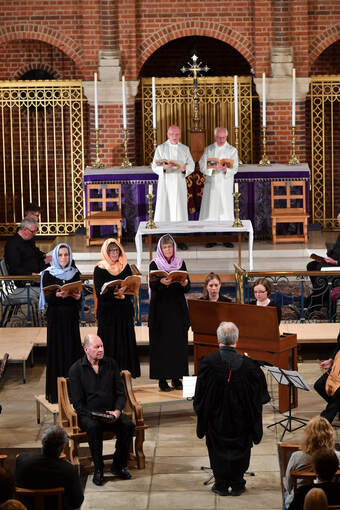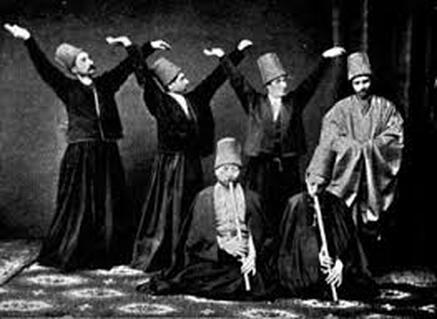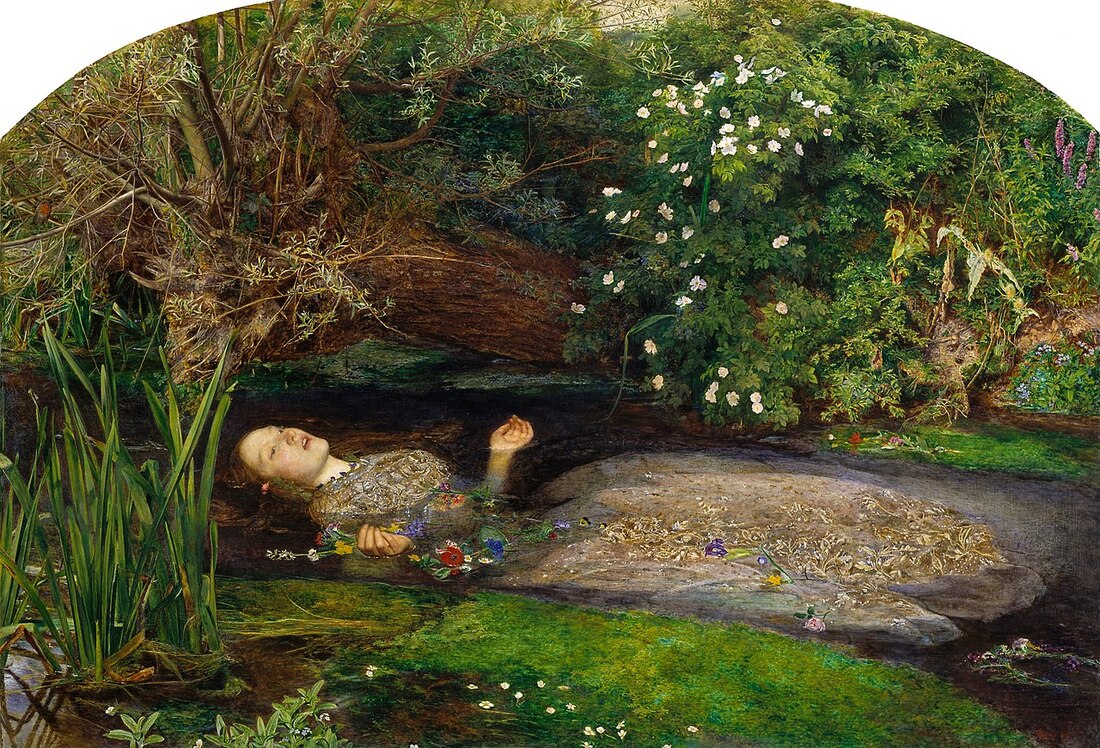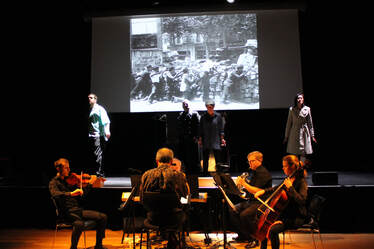|
At The Hawk's Well
Chamber Opera or Dramatic Cantata by Edward Lambert (2024) adapted from the play by W. B. Yates Characters THE GUARDIANS OF THE WELL soprano S1 mezzo-soprano S2 counter-tenor (or contralto) A CUCHULAIN, a young warrior tenor T AN OLD MAN bass-baritone B THE HAWK dancer (optional) Instruments 2 oboes, 2 horns, strings, percussion (marimba & drums), harp |
The action takes place during the Irish Heroic Age. The Three Guardians of the Well conjure a scene of a parched mountainous landscape in which they attend a dried-up spring. An Old Man has been living by the well for fifty years in the hope of drinking the water for, when it flows, he who tastes it will gain eternal life. We learn that the stream has only ever appeared when he was asleep: three times he has woken to find the stones wet but the well dry. The young hero Cuchulain arrives on the scene possessing, in the optimism of youth, the ambition of finding immortality. Suddenly, the scream of a hawk is heard and its great wings cast a shadow. Cuchulain remarks that he saw the bird on his journey here; the Old Man recognises this as a sign that the water will soon flow. When the Guardians sing again, however, the Old Man is lulled to sleep. Cuchulain is entranced by the appearance of the Hawk only to realise when it vanishes that the water has been and gone and the Old Man has died. He resolves to stay and wait for immortality. The Guardians draw a moral from the tale: wisdom is granted to those that live humble lives and are content to face death.
|
Your browser does not support viewing this document. Click here to download the document.
|
Requiem Antiqua
Dies irae & Requiem aeternam
for choir &/or solo voices SATB and organ approx. 17’ 2024
Dies irae & Requiem aeternam
for choir &/or solo voices SATB and organ approx. 17’ 2024
The Visit to the Sepulchre
an adaptation of the musical drama in the Fleury Playbook (ca. 1200)
for choir SATB, soloists and chamber organ 27’ 2017
Characters
The Three Marys - soprano 1, soprano 2, mezzo-soprano
The Two Angels - tenor 1, tenor 2
The Gardener - bass
Chorus of Mourners S(S)ATB
for Newbury Chamber Choir First performance in St John's Church, Newbury, 8th April 2017
an adaptation of the musical drama in the Fleury Playbook (ca. 1200)
for choir SATB, soloists and chamber organ 27’ 2017
Characters
The Three Marys - soprano 1, soprano 2, mezzo-soprano
The Two Angels - tenor 1, tenor 2
The Gardener - bass
Chorus of Mourners S(S)ATB
for Newbury Chamber Choir First performance in St John's Church, Newbury, 8th April 2017
“…a musical delight but a dramatic one too. This wonderful, original score drew the audience in from the start and we relished being swept along on that very journey,,, an uplifting and unforgettable evening.” (Newbury Weekly News)
This work is an adaptation for a contemporary choral performance of the musical drama Visitatio Sepulchri which survives in the manuscript known as the Fleury Playbook. (The town of Fleury is now known as St-Benoit-sur-Loire). The music is a free interpretation of the original plainsong melodies.
There is a legend of the Three Marys, having been witnesses of Christ's resurrection, escaping to France to avoid persecution. According to another legend, they were daughters of St Anne (the mother of Mary, mother of Jesus) by different husbands. Certainly, there grew many cults around them, their visit to Jesus' tomb and, subsequently, around the Holy Shroud as well. The dialogue between the Three Marys and the Angels which took place at the Sepulchre became the centre-piece of a liturgical ceremony from about the tenth century; this in turn grew into a dramatic presentation of the Easter story, and eventually gave rise to the genre of the medieval Mystery plays that spilled out onto the streets in performances by the larger community. The current version aspires to be a part of that tradition.
The Visit to the Sepulchre opens with choruses of mourners lamenting the loss of their Lord (Heu, misere); subsequent phrases begin with the word Heu! (Alas!) The people have come to anoint Christ's body (Iam properemus ad tumulum). They express their anger at the society which condemned him to death (O ira nefanda... O gens dampnanda) but resolve to achieve what they came to do before they can lay the body to rest (Eamus ergo propere). Yet they wonder how they will manage to move the stone (Sed nequinus hoc patrare).
As they turn towards the tomb they are confronted by Two Angels who ask whom they are seeking (Quem queritis in sepulcro, O Christicole?) Jesus Nazarenum is the reply. "Why do you seek the living amongst the dead?" ask the Angels. (Quid Christicole viventem queritis cum mortuis?) The mourners express their disbelief (Ad monumentem Domini) and look inside the empty tomb.
The women are further stricken with grief to find no body (Heu, quam dira doloris) while the men recall that Christ's resurrection was foretold to the disciples (Miranda sunt que vidimus!)
Now follows the dialogue between the Angels and the Three Marys: the Angels ask why they are still weeping (Mulier, quid ploras?) "They have taken my Lord", say the women (Quia tulerunt Dominum meum). "Do not mourn, he is risen", say the Angels. "We long to see him", reply the women (Ardens est cor meum). The Gardener enters and also asks why they weep and whom they seek. "Our Lord: if you have taken him away, tell me where he is", say the women (Domine, si tu sustulisti eum).
Finally, the Gardener addresses them by name and they recognise him as the risen Lord (Raboni!) He draws back. "Do not touch me", he says, "for I am not yet with my Father" (Noli me tangere).
The Three Marys give thanks (Congratulamini mihi) and the people join in a chorus of rejoicing (Venite et videte). While they marvel at the Resurrection (Surrexit Dominus) they also recall Christ's sacrifice (qui pro nobis pependit). The Angels sing as the Shroud is unfolded (Cernite, vos socii); the garment is hailed as evidence of the Resurrection amidst further rejoicing (Resurrexit hodie).
The Gardener reappears in the likeness of the Lord, now attired as Christ in majesty; he tells the people to go and spread the good news (Ite, nunciate fratribus meis). The people hail him as the brave Lion, the Son of God (Leo fortis) before singing the Te Deum (Te Deum laudamus). In a procession, the performers leave the church to a refrain of Resurrexit hodie.
This work is an adaptation for a contemporary choral performance of the musical drama Visitatio Sepulchri which survives in the manuscript known as the Fleury Playbook. (The town of Fleury is now known as St-Benoit-sur-Loire). The music is a free interpretation of the original plainsong melodies.
There is a legend of the Three Marys, having been witnesses of Christ's resurrection, escaping to France to avoid persecution. According to another legend, they were daughters of St Anne (the mother of Mary, mother of Jesus) by different husbands. Certainly, there grew many cults around them, their visit to Jesus' tomb and, subsequently, around the Holy Shroud as well. The dialogue between the Three Marys and the Angels which took place at the Sepulchre became the centre-piece of a liturgical ceremony from about the tenth century; this in turn grew into a dramatic presentation of the Easter story, and eventually gave rise to the genre of the medieval Mystery plays that spilled out onto the streets in performances by the larger community. The current version aspires to be a part of that tradition.
The Visit to the Sepulchre opens with choruses of mourners lamenting the loss of their Lord (Heu, misere); subsequent phrases begin with the word Heu! (Alas!) The people have come to anoint Christ's body (Iam properemus ad tumulum). They express their anger at the society which condemned him to death (O ira nefanda... O gens dampnanda) but resolve to achieve what they came to do before they can lay the body to rest (Eamus ergo propere). Yet they wonder how they will manage to move the stone (Sed nequinus hoc patrare).
As they turn towards the tomb they are confronted by Two Angels who ask whom they are seeking (Quem queritis in sepulcro, O Christicole?) Jesus Nazarenum is the reply. "Why do you seek the living amongst the dead?" ask the Angels. (Quid Christicole viventem queritis cum mortuis?) The mourners express their disbelief (Ad monumentem Domini) and look inside the empty tomb.
The women are further stricken with grief to find no body (Heu, quam dira doloris) while the men recall that Christ's resurrection was foretold to the disciples (Miranda sunt que vidimus!)
Now follows the dialogue between the Angels and the Three Marys: the Angels ask why they are still weeping (Mulier, quid ploras?) "They have taken my Lord", say the women (Quia tulerunt Dominum meum). "Do not mourn, he is risen", say the Angels. "We long to see him", reply the women (Ardens est cor meum). The Gardener enters and also asks why they weep and whom they seek. "Our Lord: if you have taken him away, tell me where he is", say the women (Domine, si tu sustulisti eum).
Finally, the Gardener addresses them by name and they recognise him as the risen Lord (Raboni!) He draws back. "Do not touch me", he says, "for I am not yet with my Father" (Noli me tangere).
The Three Marys give thanks (Congratulamini mihi) and the people join in a chorus of rejoicing (Venite et videte). While they marvel at the Resurrection (Surrexit Dominus) they also recall Christ's sacrifice (qui pro nobis pependit). The Angels sing as the Shroud is unfolded (Cernite, vos socii); the garment is hailed as evidence of the Resurrection amidst further rejoicing (Resurrexit hodie).
The Gardener reappears in the likeness of the Lord, now attired as Christ in majesty; he tells the people to go and spread the good news (Ite, nunciate fratribus meis). The people hail him as the brave Lion, the Son of God (Leo fortis) before singing the Te Deum (Te Deum laudamus). In a procession, the performers leave the church to a refrain of Resurrexit hodie.
An Opera of Daniel
an adaptation of the 13th century musical drama ‘Ludis Danielis”
for STB soloists, choir SATB, saxophone, double bass, drum kit and piano 50’ 2015
narration by W. H. Auden
for Newbury Chamber Choir
First performance in St John's Church, Newbury, 25 January 2015
3 performances by the Solistas Ensamble del INBA at Cenart, Mexico City, November 2017 revived June 2019
dir. Christian Gohmer
http://www.mexicoescultura.com/actividad/180771/en/an-opera-of-daniel.html
https://musicaenmexico.com.mx/cartelera/opera-de-daniel-2/
an adaptation of the 13th century musical drama ‘Ludis Danielis”
for STB soloists, choir SATB, saxophone, double bass, drum kit and piano 50’ 2015
narration by W. H. Auden
for Newbury Chamber Choir
First performance in St John's Church, Newbury, 25 January 2015
3 performances by the Solistas Ensamble del INBA at Cenart, Mexico City, November 2017 revived June 2019
dir. Christian Gohmer
http://www.mexicoescultura.com/actividad/180771/en/an-opera-of-daniel.html
https://musicaenmexico.com.mx/cartelera/opera-de-daniel-2/
The Play of Daniel survives in a beautiful manuscript which was written down in the mid-13th century but only re-discovered in the 1950s. Its music was largely compiled from other works, some of which would have been popular tunes of the day. It probably originated out of the celebrations known as the Feast of Fools or the Feast of Donkeys. The latter was performed on 14th January in honour of the flight of the Holy Family to Egypt (on a donkey) after the birth of Jesus - a sort-of epilogue to Christmas. The Feast of Fools, however, was celebrated on 1st January and this was an occasion when social mores were turned upside-down and the underdogs were in charge; townsfolk would have taken part, including women, children - and animals, real or not, including the obligatory donkey.
The ‘play’ also had a serious purpose: to drive home the message that Daniel worships the one true God. Because he is faithful he stands above his worldly masters and thus is he saved from the lions. King Darius - when tricked by the conspirators - is made to look an ass, a fool, but is then redeemed when he later orders his subjects to follow Daniel’s God. Daniel foretells the coming of a Holy One and finally the Angel announces the Birth of Christ.
The manuscript contains all the text and even stage directions, but only the pitches of the notes are given, not the rhythms. This does not necessarily mean that the music was performed as plainsong, rather that rhythmic notation was in its infancy, and many of the rhythms would have been implied by the words themselves. There were doubtless standard patterns (modes) that were common knowledge, and if the music were well-known, it would be quite easy for the performers to sing and play together.
This version has taken the original pitches (with very few changes) and added a free, rhythmic interpretation. The choruses have been adapted for a four-part choir and instruments added. It is not a scholarly reconstruction but a re-imagining of a festive celebration, and it is hoped contemporary audiences and performers can enjoy this work as it was surely intended - a community opera with all the ingredients one would hope for: wit and wisdom, drama and fun. EL
(1) The play is introduced by the ‘youths of Beauvais’ who wrote it down
(2) Belshazzar enters and mounts the throne
(3) The court sings “Rex, in aeternum vive” (“O king, live forever”) a refrain which will recur frequently throughout the work
(4) Belshazzar calls for the Holy Vessels which had been looted by his father from the Jewish Temple
(5) The court praise Belshazzar’s glorious deeds and the Vessels are ceremoniously brought in
(6) The portentous writing appears on the wall
(7) The king calls for his wise men
(8) The wise men are unable to decipher the writing
(9) The Queen enters while the court sings of her virtues
(10) She tells Belshazzar to send for Daniel, who is a Jewish slave in captivity
(11) The King orders Daniel to be fetched
(12) The Nobles address Daniel who agrees to attend
(13) Daniel approaches the court
(14) The King promises Daniel great rewards if he can interpret the words
(15) Daniel explains the writing means the King’s reign is nearly over and the kingdom will be invaded
(16) Belshazzar honours his promise to reward Daniel
(17) The Queen departs
(18) The Court retires
(19) The Persian army advances towards Babylon: Belshazzar is slain and Darius is the new leader
(20) The Nobles advise King Darius to favour the wise Daniel
(21) Messengers are sent to Daniel
(22) Once again, Daniel approaches the court
(23) Some courtiers conspire against Daniel: Darius is forced to decree that only he, the King, can answer petitions
(24) The conspirators notice Daniel praying to his God: he petitions someone else! The penalty is death by lions
(25) Daniel laments his fate
(26) The lions roar, the angels sing, Daniel prays for mercy
(27) The chief Angel tells the old man Habakkuk to take food to Daniel
(28) Daniel is grateful for the food and praises God
(29) King Darius approaches the lions’ den, hardly daring to hope that Daniel has survived
(30) To his astonishment Daniel responds with “Rex, in aeternum vive”: the Angel has saved him
(31) Darius tells his subjects to get Daniel out, and put the conspirators into the pit
(32) The conspirators say a mock prayer as they are thrown to the lions and they are quickly gobbled up
(33) Everyone rejoices
(34) Daniel prophesies the coming of a Holy One
(35) The Angel endorses this and foretells the coming of Christ
(36) Everyone sings the “Te Deum” (“We worship you, O God”) and then they depart for a well-earned drink.
The ‘play’ also had a serious purpose: to drive home the message that Daniel worships the one true God. Because he is faithful he stands above his worldly masters and thus is he saved from the lions. King Darius - when tricked by the conspirators - is made to look an ass, a fool, but is then redeemed when he later orders his subjects to follow Daniel’s God. Daniel foretells the coming of a Holy One and finally the Angel announces the Birth of Christ.
The manuscript contains all the text and even stage directions, but only the pitches of the notes are given, not the rhythms. This does not necessarily mean that the music was performed as plainsong, rather that rhythmic notation was in its infancy, and many of the rhythms would have been implied by the words themselves. There were doubtless standard patterns (modes) that were common knowledge, and if the music were well-known, it would be quite easy for the performers to sing and play together.
This version has taken the original pitches (with very few changes) and added a free, rhythmic interpretation. The choruses have been adapted for a four-part choir and instruments added. It is not a scholarly reconstruction but a re-imagining of a festive celebration, and it is hoped contemporary audiences and performers can enjoy this work as it was surely intended - a community opera with all the ingredients one would hope for: wit and wisdom, drama and fun. EL
(1) The play is introduced by the ‘youths of Beauvais’ who wrote it down
(2) Belshazzar enters and mounts the throne
(3) The court sings “Rex, in aeternum vive” (“O king, live forever”) a refrain which will recur frequently throughout the work
(4) Belshazzar calls for the Holy Vessels which had been looted by his father from the Jewish Temple
(5) The court praise Belshazzar’s glorious deeds and the Vessels are ceremoniously brought in
(6) The portentous writing appears on the wall
(7) The king calls for his wise men
(8) The wise men are unable to decipher the writing
(9) The Queen enters while the court sings of her virtues
(10) She tells Belshazzar to send for Daniel, who is a Jewish slave in captivity
(11) The King orders Daniel to be fetched
(12) The Nobles address Daniel who agrees to attend
(13) Daniel approaches the court
(14) The King promises Daniel great rewards if he can interpret the words
(15) Daniel explains the writing means the King’s reign is nearly over and the kingdom will be invaded
(16) Belshazzar honours his promise to reward Daniel
(17) The Queen departs
(18) The Court retires
(19) The Persian army advances towards Babylon: Belshazzar is slain and Darius is the new leader
(20) The Nobles advise King Darius to favour the wise Daniel
(21) Messengers are sent to Daniel
(22) Once again, Daniel approaches the court
(23) Some courtiers conspire against Daniel: Darius is forced to decree that only he, the King, can answer petitions
(24) The conspirators notice Daniel praying to his God: he petitions someone else! The penalty is death by lions
(25) Daniel laments his fate
(26) The lions roar, the angels sing, Daniel prays for mercy
(27) The chief Angel tells the old man Habakkuk to take food to Daniel
(28) Daniel is grateful for the food and praises God
(29) King Darius approaches the lions’ den, hardly daring to hope that Daniel has survived
(30) To his astonishment Daniel responds with “Rex, in aeternum vive”: the Angel has saved him
(31) Darius tells his subjects to get Daniel out, and put the conspirators into the pit
(32) The conspirators say a mock prayer as they are thrown to the lions and they are quickly gobbled up
(33) Everyone rejoices
(34) Daniel prophesies the coming of a Holy One
(35) The Angel endorses this and foretells the coming of Christ
(36) Everyone sings the “Te Deum” (“We worship you, O God”) and then they depart for a well-earned drink.
Yin & Yang Cantata
text by Don Crerar
for SB soli, strings and chamber organ 11’ 2015
Performed and recorded live by Joanna Hodgson, Jeremy Hagan, The Music Troupe, Newbury Chamber Choir, Susan Holmes (chamber organ), conducted by Edward Lambert in St John’s Church, Newbury, April 2016
When I heard Don Crerar recite this beautiful love poem [in 2014], I was keen to attempt a musical setting. The text would have to be simply set, with little adornment, but the music might bring out the tensions between the ‘counterpoints’ in the text and even, perhaps, hint at the pain of love and loss. The piece is as much about the instruments as it is about the voices, a complementary relationship each fulfilling the other. The strings begin by weaving descending and ascending melodies between alternating major and minor chords, like a current across the poles of a battery. Another source of tension is that between two-time and three-time rhythms: the music flows back and forth, becoming more animated later in the piece. The soprano and bass share all the text and mostly sing together, so they’re equal partners. Ultimately, however, the piece is about harmony - that peculiar thing whereby the significance of a sound depends on the way it combines with others - and the constantly revolving chords aim to give the piece an appropriate ambiguity. (EL)
text by Don Crerar
for SB soli, strings and chamber organ 11’ 2015
Performed and recorded live by Joanna Hodgson, Jeremy Hagan, The Music Troupe, Newbury Chamber Choir, Susan Holmes (chamber organ), conducted by Edward Lambert in St John’s Church, Newbury, April 2016
When I heard Don Crerar recite this beautiful love poem [in 2014], I was keen to attempt a musical setting. The text would have to be simply set, with little adornment, but the music might bring out the tensions between the ‘counterpoints’ in the text and even, perhaps, hint at the pain of love and loss. The piece is as much about the instruments as it is about the voices, a complementary relationship each fulfilling the other. The strings begin by weaving descending and ascending melodies between alternating major and minor chords, like a current across the poles of a battery. Another source of tension is that between two-time and three-time rhythms: the music flows back and forth, becoming more animated later in the piece. The soprano and bass share all the text and mostly sing together, so they’re equal partners. Ultimately, however, the piece is about harmony - that peculiar thing whereby the significance of a sound depends on the way it combines with others - and the constantly revolving chords aim to give the piece an appropriate ambiguity. (EL)
“In Chinese philosophy, yin and yang describes how opposite or contrary forces are actually complementary, interconnected, and interdependent in the natural world, and how they give rise to each other as they interrelate to one another. Many tangible dualities (such as light and dark, fire and water, expanding and contracting) are thought of as physical manifestations of the duality symbolised by yin and yang: complementary (rather than opposing) forces whose combination is greater than its constituent parts.” (Wikipedia)
This sign for us is fitly coined
For hearts divided and conjoined
You are soul and I am mind
I to look and you to find.
I the murmur, you the shout
You the reason, I the doubt.
You acceptance, I mistrust
You the dew and I the dust
I constraint and you release
I at arms and you at peace
I the dark and you the light
You at noon and I midnight
You are warm where I am cold
I the heath and you the fold
Thus head to tail, around we roll
Contending halves, a perfect whole
(Don Crerar)
For hearts divided and conjoined
You are soul and I am mind
I to look and you to find.
I the murmur, you the shout
You the reason, I the doubt.
You acceptance, I mistrust
You the dew and I the dust
I constraint and you release
I at arms and you at peace
I the dark and you the light
You at noon and I midnight
You are warm where I am cold
I the heath and you the fold
Thus head to tail, around we roll
Contending halves, a perfect whole
(Don Crerar)
The Inarticulate Burr
text by Edward Dowden (1843-1913): “The Secret of the Universe”
for STB soli, choir SATB and instrumental ensemble:
2 flutes, oboe, harp, 2 string quartets, double bass 13’ 2013
Edward Dowden was a renowned Irish critic and poet of the late Victorian period. With an distinguished academic career spanning Dublin, Oxford and Cambridge he wrote extensively on Shakespeare, Shelley, Goethe and a host of other writers. It is not known how and why he came to write this extraordinary text subtitled ‘An Ode (By a Western Spinning Dervish)’. The Victorians were certainly interested in other cultures: English translations of the vast body of Persian poetry began to appear in England in the 1880’s and it may have been through these publications that Dowden became acquainted with the philosophy of Rumi and the Mevlevi Order. Rumi was a 13th century Sufi mystic, and a passionate advocate of the use of music, dance and poetry as a way of reaching God. The Sema ritual that has been practised ever since represents a mystical journey, the ascent of the spirit to the Perfect One. Certainly, Dowden’s poem elucidates (in a curiously Irish kind of way) the essence of the Sema ceremony very well. This setting of it makes no attempt to depict the rituals but, rather, to interpret a Victorian text that, for its period, seems peculiarly unrestrained.
Performed and recorded by Elaine McKrill, Daniel Meades, Jeremy Hagan, The Music Troupe, Newbury Chamber Choir, conducted by Edward Lambert at the Arlington Arts Centre, Newbury, June 2014
text by Edward Dowden (1843-1913): “The Secret of the Universe”
for STB soli, choir SATB and instrumental ensemble:
2 flutes, oboe, harp, 2 string quartets, double bass 13’ 2013
Edward Dowden was a renowned Irish critic and poet of the late Victorian period. With an distinguished academic career spanning Dublin, Oxford and Cambridge he wrote extensively on Shakespeare, Shelley, Goethe and a host of other writers. It is not known how and why he came to write this extraordinary text subtitled ‘An Ode (By a Western Spinning Dervish)’. The Victorians were certainly interested in other cultures: English translations of the vast body of Persian poetry began to appear in England in the 1880’s and it may have been through these publications that Dowden became acquainted with the philosophy of Rumi and the Mevlevi Order. Rumi was a 13th century Sufi mystic, and a passionate advocate of the use of music, dance and poetry as a way of reaching God. The Sema ritual that has been practised ever since represents a mystical journey, the ascent of the spirit to the Perfect One. Certainly, Dowden’s poem elucidates (in a curiously Irish kind of way) the essence of the Sema ceremony very well. This setting of it makes no attempt to depict the rituals but, rather, to interpret a Victorian text that, for its period, seems peculiarly unrestrained.
Performed and recorded by Elaine McKrill, Daniel Meades, Jeremy Hagan, The Music Troupe, Newbury Chamber Choir, conducted by Edward Lambert at the Arlington Arts Centre, Newbury, June 2014
|
Edward Dowden (1843-1913)
The Secret of the Universe An Ode (By a Western Spinning Dervish) I SPIN, I spin, around, around, And close my eyes, And let the bile arise From the sacred region of the soul’s Profound; Then gaze upon the world; how strange! how new! The earth and heaven are one, The horizon-line is gone, The sky how green! the land how fair and blue! Perplexing items fade from my large view, And thought which vexed me with its false and true Is swallowed up in Intuition; this, This is the sole true mode Of reaching God, And gaining the universal synthesis Which makes All—One; while fools with peering eyes Dissect, divide, and vainly analyse. So round, and round, and round again! How the whole globe swells within my brain, The stars inside my lids appear, The murmur of the spheres I hear Throbbing and beating in each ear; Right in my navel I can feel The centre of the world’s great wheel. Ah peace divine, bliss dear and deep, No stay, no stop, Like any top Whirling with swiftest speed, I sleep. O ye devout ones round me coming, Listen! I think that I am humming; No utterance of the servile mind With poor chop-logic rules agreeing Here shall ye find, But inarticulate burr of man’s unsundered being. Ah, could we but devise some plan, Some patent jack by which a man Might hold himself ever in harmony With the great whole, and spin perpetually, As all things spin Without, within, As Time spins off into Eternity, And Space into the inane Immensity, And the Finite into God’s Infinity, Spin, spin, spin, spin. |
Mevlevi dervishes 1887 (Wikipedia)
"The Sema, (the dance of the whirling dervishes, or semazens), has been celebrated since Mevlana's passing on December 17, 1273. Hazreti Mevlana's realization expresses the source of all religions and spiritual paths -- the Way of Love -- uniting those of many cultures and traditions. Everyone attending the Sema is a participant. As the ceremony unfolds, any apparent distinction between "audience" and "dervish" dissolves as all are attuned, by the music and language of tht Heart, to the baraka (blessing) filled atmosphere of love. As planets and stars circle the sun, the dervishes turn counterclockwise, both around themselves and around the halka (circle). They turn first with crossed arms; then, taking flight, they open their arms, holding the right hand up and the left hand down, becoming transparent vessels for bringing divine blessings to earth. Pervading the space is the Remembrance of God (Zikr), through the silent chanting of the holy name name of God, Allah, invoked within the heart by all. Turning becomes a travel through the universe before God, the spiritual sun of the worlds. The semazens first turn to dissolve their doubts into belief in God's unifying presence. Then, belief deepens, becoming faith, and the semazens scale the heights, to the abode of absolute existence, of Unity. With God's grace, it is here that everyone drinks deeply from the same source of life and love that united Mevlana and Shams hundreds of years ago. The eternal bridge they became, as teacher and student, lover and beloved, still beckons the spiritual traveler who is willing to risk all in its precarious course. Finally, the semazens return to stillness. At the sound of verses from the Koran the whirling stops, the dervishes kiss the floor, raise their hands in prayer, and ask for God's blessings with the silent recitation of the Surah al-Fatiha, the opening chapter of Quran. In unison, the dervishes kiss the floor, and invoke the blessings of God. "Selamun Aleykum" ("God's Peace be with you") echoes through the space. The dervishes intone together the sacred name of God, "Hu", and bow together once again before leaving the sema hall." The Inarticulate Burr is a response to the Victorian poem, not a depiction of the Sema itself. |
Shelley’s Hymn
text by Pecry Bysshe Shelley (1792-1822): “Hymn to Intellectual Beauty”
for STB soli, choir SATB and instrumental ensemble:
2 flutes, oboe, harp, 2 string quartets, double bass 32’ 2013
text by Pecry Bysshe Shelley (1792-1822): “Hymn to Intellectual Beauty”
for STB soli, choir SATB and instrumental ensemble:
2 flutes, oboe, harp, 2 string quartets, double bass 32’ 2013
|
Percy Bysshe Shelley (1792-1822)
Hymn to Intellectual Beauty An Ode THE AWFUL shadow of some unseen Power Floats though unseen among us,—visiting This various world with as inconstant wing As summer winds that creep from flower to flower,-- Like moonbeams that behind some piny mountain shower, It visits with inconstant glance Each human heart and countenance; Like hues and harmonies of evening,-- Like clouds in starlight widely spread,-- Like memory of music fled,-- Like aught that for its grace may be Dear, and yet dearer for its mystery. Spirit of BEAUTY, that dost consecrate With thine own hues all thou dost shine upon Of human thought or form,—where art thou gone? Why dost thou pass away and leave our state, This dim vast vale of tears, vacant and desolate? Ask why the sunlight not for ever Weaves rainbows o’er yon mountain-river, Why aught should fail and fade that once is shown, Why fear and dream and death and birth Cast on the daylight of this earth Such gloom,—why man has such a scope For love and hate, despondency and hope? No voice from some sublimer world hath ever To sage or poet these responses given-- Therefore the names of Demon, Ghost, and Heaven, Remain the records of their vain endeavour, Frail spells—whose uttered charm might not avail to sever, From all we hear and all we see, Doubt, chance, and mutability. Thy light alone—like mist o’er mountains driven, Or music by the night-wind sent Through strings of some still instrument, Or moonlight on a midnight stream, Gives grace and truth to life’s unquiet dream. Love, Hope, and Self-esteem, like clouds depart And come, for some uncertain moments lent. Man were immortal, and omnipotent, Didst thou, unknown and awful as thou art, Keep with thy glorious train firm state within his heart. Thou messenger of sympathies, That wax and wane in lovers’ eyes-- Thou—that to human thought art nourishment, Like darkness to a dying flame! Depart not as thy shadow came, Depart not—lest the grave should be, Like life and fear, a dark reality. |
While yet a boy I sought for ghosts, and sped Through many a listening chamber, cave and ruin, And starlight wood, with fearful steps pursuing Hopes of high talk with the departed dead. I called on poisonous names with which our youth is fed; I was not heard—I saw them not-- When musing deeply on the lot Of life, at that sweet time when winds are wooing All vital things that wake to bring News of birds and blossoming,-- Sudden, thy shadow fell on me; I shrieked, and clasped my hands in ecstasy! I vowed that I would dedicate my powers To thee and thine—have I not kept the vow? With beating heart and streaming eyes, even now I call the phantoms of a thousand hours Each from his voiceless grave: they have in visioned bowers Of studious zeal or love’s delight Outwatched with me the envious night-- They know that never joy illumed my brow Unlinked with hope that thou wouldst free This world from its dark slavery, That thou—O awful LOVELINESS, Wouldst give whate’er these words cannot express. The day becomes more solemn and serene When noon is past—there is a harmony In autumn, and a lustre in its sky, Which through the summer is not heard or seen, As if it could not be, as if it had not been! Thus let thy power, which like the truth Of nature on my passive youth Descended, to my onward life supply Its calm—to one who worships thee, And every form containing thee, Whom, SPIRIT fair, thy spells did bind To fear himself, and love all human kind. |
The First Christmas Tree
text after Eugene Field (1850-1895)
Cantata for tenor solo, children's choir SA, mixed choir SATB and organ 30’ 2012
The text is adapted by the composer from the children's short story The First Christmas Tree by Eugene Field (1850-1895) with additional concluding lines from The Dream of the Rood and Charles Dickens' A Christmas Tree.
Voices:
The Storyteller: Tenor
The Tree: Soprano (from the chorus)
Angels: Semi-Chorus of children's voices SA
Trees of the Forest: Choir SATB
The trees of the forest hear the angels proclaiming a holy birth; the angels enter the forest and protect a small Tree which, in the fullness of time, grows serene and beautiful. The Master and his friends often come to visit the Tree, but one day he comes alone, distressed. The guardian angels disappear and into the forest come cruel men who fell the Tree and carry it away. The wind brings news that the Tree has been transformed into a Cross, and the Master has died upon it. However, the forest sees the Tree rising to the heavens, decorated with gold and jewellery; the angels have returned to it and, together with the stars, dance on its branches. Thus is the Tree celebrated at Christmas time.
First performance on 8 December 2012 in St Nicolas Church, Newbury
Paul Robinson (tenor) Stephen Westrop (piano) David Coram (organ) Newbury Chamber Choir conducted by Edward Lambert
text after Eugene Field (1850-1895)
Cantata for tenor solo, children's choir SA, mixed choir SATB and organ 30’ 2012
The text is adapted by the composer from the children's short story The First Christmas Tree by Eugene Field (1850-1895) with additional concluding lines from The Dream of the Rood and Charles Dickens' A Christmas Tree.
Voices:
The Storyteller: Tenor
The Tree: Soprano (from the chorus)
Angels: Semi-Chorus of children's voices SA
Trees of the Forest: Choir SATB
The trees of the forest hear the angels proclaiming a holy birth; the angels enter the forest and protect a small Tree which, in the fullness of time, grows serene and beautiful. The Master and his friends often come to visit the Tree, but one day he comes alone, distressed. The guardian angels disappear and into the forest come cruel men who fell the Tree and carry it away. The wind brings news that the Tree has been transformed into a Cross, and the Master has died upon it. However, the forest sees the Tree rising to the heavens, decorated with gold and jewellery; the angels have returned to it and, together with the stars, dance on its branches. Thus is the Tree celebrated at Christmas time.
First performance on 8 December 2012 in St Nicolas Church, Newbury
Paul Robinson (tenor) Stephen Westrop (piano) David Coram (organ) Newbury Chamber Choir conducted by Edward Lambert
Funeral Sentences
Settings of texts from the Burial of the Dead in the Book of Common Prayer
for Choir SATB and Organ 14’ 2012
Settings of texts from the Burial of the Dead in the Book of Common Prayer
for Choir SATB and Organ 14’ 2012
Brighter than the Sun
A Cantata for Christmas
A miscellany of carols and scenes from the Mystery Plays on the theme of the Annunciation
Mary - soprano, The Angel Gabriel - tenor, Joseph - bass, Choir - SATB,
flute, horn, violin, viola, cello and harp 2011 38’
This cantata, which takes as its theme the Annunciation, contains arrangements of four medieval carols for SATB choir with instrumental accompaniment (ad lib) and for which I have provided singing translations with the intention of making these beautiful pieces more accessible to contemporary choirs and audiences. The remaining movements are original and contain a semi-dramatic triptych: there are settings of two scenes extracted from the medieval mystery plays with the text freely adapted for musical purposes. A third, central scene is for Mary alone, in which she sings the Magnificat from the Book of Common Prayer. In addition, there are two short instrumental sonatas and a setting for sopranos and altos of the 13th century lyric known as a hymn to the Virgin. The work was created as a companion piece to the composer's English arrangement of Schütz' Christmas Story for a concert given by the Newbury Chamber Choir in December 2011. Although the cantata is designed to be performed as a whole, any sections from the work may be performed in any order.
Recording of first performance, Newbury 2011 - Kristy Swift (soprano), Peter Wilman (tenor), Jeremy Hagan (bass), Newbury Chamber Choir & Players, conducted by Edward Lambert
A Cantata for Christmas
A miscellany of carols and scenes from the Mystery Plays on the theme of the Annunciation
Mary - soprano, The Angel Gabriel - tenor, Joseph - bass, Choir - SATB,
flute, horn, violin, viola, cello and harp 2011 38’
This cantata, which takes as its theme the Annunciation, contains arrangements of four medieval carols for SATB choir with instrumental accompaniment (ad lib) and for which I have provided singing translations with the intention of making these beautiful pieces more accessible to contemporary choirs and audiences. The remaining movements are original and contain a semi-dramatic triptych: there are settings of two scenes extracted from the medieval mystery plays with the text freely adapted for musical purposes. A third, central scene is for Mary alone, in which she sings the Magnificat from the Book of Common Prayer. In addition, there are two short instrumental sonatas and a setting for sopranos and altos of the 13th century lyric known as a hymn to the Virgin. The work was created as a companion piece to the composer's English arrangement of Schütz' Christmas Story for a concert given by the Newbury Chamber Choir in December 2011. Although the cantata is designed to be performed as a whole, any sections from the work may be performed in any order.
Recording of first performance, Newbury 2011 - Kristy Swift (soprano), Peter Wilman (tenor), Jeremy Hagan (bass), Newbury Chamber Choir & Players, conducted by Edward Lambert
Rossetti Requiem
Settings of texts by Christina Rossetti
for Soloists (SATB), Choir (SATB) and Orchestra (2 fl, 2 bsn, 2 hn, perc & strings) 2010 55’
Mankind’s spiritual journey through life and our attitude to death provide the themes of Christina Rossetti’s best work: the relationships between living and loving on the one hand, and grieving and memory on the other. The first poem in this cycle confronts the physical reality of death and tauntingly asks how far memory will reach beyond the grave. After musing on the transience of worldly things (no.2), the poet embarks on a spiritual quest (no.3). Love and youth are recalled (no.4) before a reflection that the ultimate act of love is to relinquish it (no.5). Even spring-life is destined to die (no.6), yet grief is hard to bear and memories are real (no.7). All we can do is search (no.8) and our journey will be its own reward (no.9).
first performance November 2010, Jacqueline Pischorn (soprano), Grace Wain (mezzo-soprano), Paul Robinson (tenor), Ian Caddy (bass)
Newbury Chamber Choir & Orchestra, conducted by the composer
Settings of texts by Christina Rossetti
for Soloists (SATB), Choir (SATB) and Orchestra (2 fl, 2 bsn, 2 hn, perc & strings) 2010 55’
Mankind’s spiritual journey through life and our attitude to death provide the themes of Christina Rossetti’s best work: the relationships between living and loving on the one hand, and grieving and memory on the other. The first poem in this cycle confronts the physical reality of death and tauntingly asks how far memory will reach beyond the grave. After musing on the transience of worldly things (no.2), the poet embarks on a spiritual quest (no.3). Love and youth are recalled (no.4) before a reflection that the ultimate act of love is to relinquish it (no.5). Even spring-life is destined to die (no.6), yet grief is hard to bear and memories are real (no.7). All we can do is search (no.8) and our journey will be its own reward (no.9).
first performance November 2010, Jacqueline Pischorn (soprano), Grace Wain (mezzo-soprano), Paul Robinson (tenor), Ian Caddy (bass)
Newbury Chamber Choir & Orchestra, conducted by the composer
A Wedding in Florence (1539)
Music for the marriage festivities of Eleonora di Toledo and Cosimo de'Medici arranged and augmented with Songs for a Florentine Apollo
for soloists, choir and instrumental ensemble about 80 minutes 2017
This work contains the full Wedding Music of 1539 taken from A Renaissance Entertainment by Minor & Mitchell (University of Missouri 1968)
first performance by Newbury Chamber Choir 28 April 2018
Voices
Group 1 (soli) SATB
Group 2 (choir or soli) SATB
Apollo, master of ceremonies: baritone solo
Giambullari, man of letters: narrator (spoken)
Instruments
Flute 1 (doubling piccolo)
Flute 2 (doubling alto flute)
Horns 1 & 2 (in F)
Bassoon
Cello &/or Double bass
Harp (or Harpsichord)
Chamber Organ
Music for the marriage festivities of Eleonora di Toledo and Cosimo de'Medici arranged and augmented with Songs for a Florentine Apollo
for soloists, choir and instrumental ensemble about 80 minutes 2017
This work contains the full Wedding Music of 1539 taken from A Renaissance Entertainment by Minor & Mitchell (University of Missouri 1968)
first performance by Newbury Chamber Choir 28 April 2018
Voices
Group 1 (soli) SATB
Group 2 (choir or soli) SATB
Apollo, master of ceremonies: baritone solo
Giambullari, man of letters: narrator (spoken)
Instruments
Flute 1 (doubling piccolo)
Flute 2 (doubling alto flute)
Horns 1 & 2 (in F)
Bassoon
Cello &/or Double bass
Harp (or Harpsichord)
Chamber Organ
Introduction
By 1539, the young Cosimo de’Medici (1519-1574) had already succeeded in restoring the power of the Medici dynasty and with it, the fortunes of Florence. The festivities for his marriage were designed to reinforce Cosimo’s pre-eminence in Italian politics which he had achieved through his bond with the Holy Roman Emperor, Charles V, the ruler of Spain. Cosimo’s fortunate choice of wife was the seventeen year-old Eleonora di Toledo (1522-1562), daughter of the Spanish viceroy of Naples. But apart from the huge political significance of the match, he was in love with his bride, having rejected her older sister, and the marriage turned out to be a happy one. The many sons and daughters of the union not only ensured the successsion of the Medici family which went on to rule Tuscany for another 200 years, but also connected it to nobility throughout Italy and beyond. This new golden era in the history of Florence began with the wedding festivities of 1539...
The festivities might have faded into historical obscurity were it not for the pen of Pier Francesco Giambullari (1495-1555) who was commissioned by the Medici family to send a report to Charles V through the Medici’s ambassador at his court. Giambullari was a member of the Florentine intellectual establishment and his account constitutes a literary and historical document in its own right. It is immensely detailed, describing every nuance of artistic decor and costume. It started a trend that was to become common thereafter, namely the meticulous recording of ceremonies connected to the grand events of the times.
In Giambullari's account there is no mention of any religious ceremony. The celebrations began when the couple arrived at the gates of Florence where a welcoming arch had been erected. On either side of this stood musicians and singers performing Ingredere felicissimis. An 8-part ceremonial motet, this is municipal music at its grandest and most eloquent: as the couple walked around and through the archway, they would have heard different voices and instruments standing out from the texture, much as the arch itself was lavishly decorated with reliefs.
A few days later was held the most important of the festivities: the wedding banquet, with invited nobles from Florence and abroad. This was a political statement, designed to impress the spectators with the strength of Medici power and the size of its wealth. But the cabaret that accompanied it was also a wedding present for the seventeen year old, fun loving Eleonora: what better way to entertain a new bride than to present a variety show with, as its theme, portraits of the country that she would now rule over?
After an initial 9-part Hymn to Hymen (the god of marriage, moved to the end of this sequence), there stepped forward in turn Flora (as Florence) Pisa, Volterra, Arezzo, Cordona, and Pistoia, all dancing, acting and singing. These cities were under Medici control (though it was not until 1569 that Cosimo would be styled Duke of Tuscany). In their various ways, they pay homage to the newly married couple. The fly in the ointment was Pistoia, which had recovered from civil unrest when the poetry for the banquet was written but by the time of the performance had succumbed to rebellion again. The last of the tributes was from Rome, called the Tiber out of political sensitivity, and as if to underline the fact that these two cities reflected each other’s glory (the Medicis had a few popes to their name), this is set as an echo chorus, a play on the word ecco (here).
Another wedding event, on 9th July, was the performance of a play, a commedia entitled Il Commodo (A Happy Arrangement) by Antonio Landi. Giambullari reproduces the entire script in his letter. The significance of this performance is that it was punctuated by seven musical interludes or intermedii which delineate times of the day, through the appearance of Dawn, Shepherds, Mermaids, Huntresses, and Night. Noon is personified by Silenus, a character in Virgil, found sleeping in his cave at midday. The entertainment was brought to a rousing finale by Bacchus, a celebration of wine and merrymaking.
A Wedding in Florence presents the complete music from 1539 - but mixes the original sequence of events by inserting the intermedi between items for the wedding banquet.
Finally, the first singer to appear at the wedding banquet was the figure of Apollo. He acted as Master of Ceremonies, introducing each scene with poetic recitations. Rather long-winded, as befits perhaps his godly status, he refers to the symbolism of the costumes and the decor with reference to the places they represent, explaining it all to his audience in flowery language. All his poetry is recorded by Giambullari, but no music has survived: this version sets this poetry, much abridged, for solo baritone to form short, new intermezzi of a contrasting kind which are intended to pay homage to those creators, performers and spectators in Tuscany 1539 from the perspective, as it were, of the subsequent story of Italian opera. I have called these items Songs for a Florentine Apollo.
EL November 2017
By 1539, the young Cosimo de’Medici (1519-1574) had already succeeded in restoring the power of the Medici dynasty and with it, the fortunes of Florence. The festivities for his marriage were designed to reinforce Cosimo’s pre-eminence in Italian politics which he had achieved through his bond with the Holy Roman Emperor, Charles V, the ruler of Spain. Cosimo’s fortunate choice of wife was the seventeen year-old Eleonora di Toledo (1522-1562), daughter of the Spanish viceroy of Naples. But apart from the huge political significance of the match, he was in love with his bride, having rejected her older sister, and the marriage turned out to be a happy one. The many sons and daughters of the union not only ensured the successsion of the Medici family which went on to rule Tuscany for another 200 years, but also connected it to nobility throughout Italy and beyond. This new golden era in the history of Florence began with the wedding festivities of 1539...
The festivities might have faded into historical obscurity were it not for the pen of Pier Francesco Giambullari (1495-1555) who was commissioned by the Medici family to send a report to Charles V through the Medici’s ambassador at his court. Giambullari was a member of the Florentine intellectual establishment and his account constitutes a literary and historical document in its own right. It is immensely detailed, describing every nuance of artistic decor and costume. It started a trend that was to become common thereafter, namely the meticulous recording of ceremonies connected to the grand events of the times.
In Giambullari's account there is no mention of any religious ceremony. The celebrations began when the couple arrived at the gates of Florence where a welcoming arch had been erected. On either side of this stood musicians and singers performing Ingredere felicissimis. An 8-part ceremonial motet, this is municipal music at its grandest and most eloquent: as the couple walked around and through the archway, they would have heard different voices and instruments standing out from the texture, much as the arch itself was lavishly decorated with reliefs.
A few days later was held the most important of the festivities: the wedding banquet, with invited nobles from Florence and abroad. This was a political statement, designed to impress the spectators with the strength of Medici power and the size of its wealth. But the cabaret that accompanied it was also a wedding present for the seventeen year old, fun loving Eleonora: what better way to entertain a new bride than to present a variety show with, as its theme, portraits of the country that she would now rule over?
After an initial 9-part Hymn to Hymen (the god of marriage, moved to the end of this sequence), there stepped forward in turn Flora (as Florence) Pisa, Volterra, Arezzo, Cordona, and Pistoia, all dancing, acting and singing. These cities were under Medici control (though it was not until 1569 that Cosimo would be styled Duke of Tuscany). In their various ways, they pay homage to the newly married couple. The fly in the ointment was Pistoia, which had recovered from civil unrest when the poetry for the banquet was written but by the time of the performance had succumbed to rebellion again. The last of the tributes was from Rome, called the Tiber out of political sensitivity, and as if to underline the fact that these two cities reflected each other’s glory (the Medicis had a few popes to their name), this is set as an echo chorus, a play on the word ecco (here).
Another wedding event, on 9th July, was the performance of a play, a commedia entitled Il Commodo (A Happy Arrangement) by Antonio Landi. Giambullari reproduces the entire script in his letter. The significance of this performance is that it was punctuated by seven musical interludes or intermedii which delineate times of the day, through the appearance of Dawn, Shepherds, Mermaids, Huntresses, and Night. Noon is personified by Silenus, a character in Virgil, found sleeping in his cave at midday. The entertainment was brought to a rousing finale by Bacchus, a celebration of wine and merrymaking.
A Wedding in Florence presents the complete music from 1539 - but mixes the original sequence of events by inserting the intermedi between items for the wedding banquet.
Finally, the first singer to appear at the wedding banquet was the figure of Apollo. He acted as Master of Ceremonies, introducing each scene with poetic recitations. Rather long-winded, as befits perhaps his godly status, he refers to the symbolism of the costumes and the decor with reference to the places they represent, explaining it all to his audience in flowery language. All his poetry is recorded by Giambullari, but no music has survived: this version sets this poetry, much abridged, for solo baritone to form short, new intermezzi of a contrasting kind which are intended to pay homage to those creators, performers and spectators in Tuscany 1539 from the perspective, as it were, of the subsequent story of Italian opera. I have called these items Songs for a Florentine Apollo.
EL November 2017
Mass for Four Voices
for SATB soli 26’ 1983
First performed at the Huddersfield Festival of Contemporary Music 1984 and subsequently on BBC Radio Three
This setting of the Mass Ordinary was intended to give a quartet of voices - with the phenomenal abilities of these performers - a concert piece of substance which might compare with, say, a string quartet, and in this way refer back to the medium of a consort of voices largely neglected since Renaissance times. The piece is also ambitious in having been planned in one movement: the text of the Mass, while important, is subsidiary to the way the music unfolds.
performed and recorded live by Rosemary Hardy (soprano), Linda Hurst (contralto), Martyn Hill (tenor), Stephen Varcoe (bass)
for SATB soli 26’ 1983
First performed at the Huddersfield Festival of Contemporary Music 1984 and subsequently on BBC Radio Three
This setting of the Mass Ordinary was intended to give a quartet of voices - with the phenomenal abilities of these performers - a concert piece of substance which might compare with, say, a string quartet, and in this way refer back to the medium of a consort of voices largely neglected since Renaissance times. The piece is also ambitious in having been planned in one movement: the text of the Mass, while important, is subsidiary to the way the music unfolds.
performed and recorded live by Rosemary Hardy (soprano), Linda Hurst (contralto), Martyn Hill (tenor), Stephen Varcoe (bass)
Te Deum
for Choir SATB and piano 12’ 2000
performed and recorded by the Newbury Chamber Choir with David Owen Norris (piano) conducted by Edward Lambert, St Nicolas' Church, Newbury, June 2008
for Choir SATB and piano 12’ 2000
performed and recorded by the Newbury Chamber Choir with David Owen Norris (piano) conducted by Edward Lambert, St Nicolas' Church, Newbury, June 2008
Duo Seraphim
SA or TB and Organ 7’ 1999
A setting of the Isaiah text
SA or TB and Organ 7’ 1999
A setting of the Isaiah text
Magnificat & Nunc Dimittis
A setting of the Evening Canticles for Choir SATB and Organ 12’ 1999
A setting of the Evening Canticles for Choir SATB and Organ 12’ 1999
Pange Lingua
a setting of the hymn by St Thomas Aquinas for unaccompanied Choir [or soli] SATB 7’ 1978
Pange lingua gloriosi
corporis mysterium
sanguinisque pretiosi
fructus ventris generosi
rex effudit gentium.
Amen.
Performed and recorded ca. 1978
a setting of the hymn by St Thomas Aquinas for unaccompanied Choir [or soli] SATB 7’ 1978
Pange lingua gloriosi
corporis mysterium
sanguinisque pretiosi
fructus ventris generosi
rex effudit gentium.
Amen.
Performed and recorded ca. 1978
Meditation on a Ruin
A setting of the Old English poem for voices and strings.
4S 4A 4T 4B, 2 string quartets, double bass 17’ 1998
The text is a transliteration of the original Anglo-Saxon
The Meditation on a Ruin is a setting of the Anglo-Saxon text The Ruin which is thought, perhaps, to be a depiction of what was left of the Roman city of Bath as seen through the eyes of the poet. What the Anglo-Saxons made of the many Roman ruins that lay around them can only be wondered at. And, surely, this is the fascination of any ruin (and hence the title Meditation): that the imagination immediately tries to picture life when those buildings flourished? A Ruin becomes an interaction between the beholder and the decayed fabric which he contemplates. The text cleverly oscillates between a description of the stones and a reconstruction of a past life and so this musical setting aims not at pictorial description of a lost city but rather at the emotions which images of the past evoke in us, whether those images be actual and archaeological or our own imaginings derived from them. To emphasise all this, the text - which has itself survived only incomplete - is set in the original Old English (using a transliteration that is easy for singers to use).
A setting of the Old English poem for voices and strings.
4S 4A 4T 4B, 2 string quartets, double bass 17’ 1998
The text is a transliteration of the original Anglo-Saxon
The Meditation on a Ruin is a setting of the Anglo-Saxon text The Ruin which is thought, perhaps, to be a depiction of what was left of the Roman city of Bath as seen through the eyes of the poet. What the Anglo-Saxons made of the many Roman ruins that lay around them can only be wondered at. And, surely, this is the fascination of any ruin (and hence the title Meditation): that the imagination immediately tries to picture life when those buildings flourished? A Ruin becomes an interaction between the beholder and the decayed fabric which he contemplates. The text cleverly oscillates between a description of the stones and a reconstruction of a past life and so this musical setting aims not at pictorial description of a lost city but rather at the emotions which images of the past evoke in us, whether those images be actual and archaeological or our own imaginings derived from them. To emphasise all this, the text - which has itself survived only incomplete - is set in the original Old English (using a transliteration that is easy for singers to use).
Maxims, Hymn, Riddle
Three movements on Old English texts for TTB soli 20’ 1980
Commissioned by the Spiral Dance Company, Liverpool
Live recording by Charles Daniels, Peter Long, (tenors) Gareth Morell (baritone)
Three movements on Old English texts for TTB soli 20’ 1980
Commissioned by the Spiral Dance Company, Liverpool
Live recording by Charles Daniels, Peter Long, (tenors) Gareth Morell (baritone)
